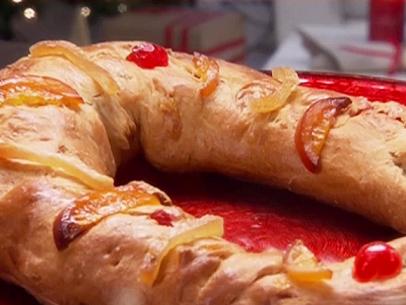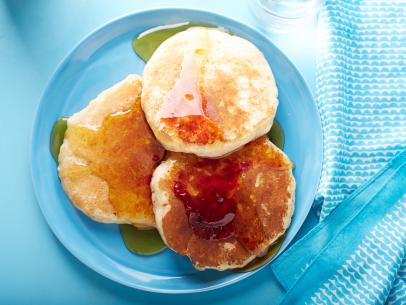
Recipe courtesy of Andrea Aliseda
Recipe courtesy of Andrea Aliseda
Watch how to make this recipe.
Vegan Rosca de Reyes
Getting reviews...
- Level: Intermediate
- Total: 6 hr 30 min
- Active: 1 hr 50 min
- Yield: 8 to 10 servings
-
- Nutritional Analysis
- Per Serving
- Serving Size
- 1 of 10 servings
- Calories
- 590
- Total Fat
- 28 g
- Saturated Fat
- 26 g
- Carbohydrates
- 77 g
- Dietary Fiber
- 4 g
- Sugar
- 27 g
- Protein
- 8 g
- Cholesterol
- 1 mg
- Sodium
- 282 mg
Día de los Reyes Magos is a special winter holiday in Mexico that celebrates the biblical story of the three wise kings’ journey to visit the newborn king, Jesus Christ. It’s celebrated with a sweet bread we call rosca de reyes, traditionally decorated with sugar paste and dried and candied fruits like figs, oranges, quince paste, acitrón and cherries. Hidden inside are plastic figurines of baby Jesus. Those who find the first baby in their slice are said to be so blessed that they must share their good fortune by making or bringing tamales to a follow-up party on February 2 called el Dia de la Candelaria. Typically, rosca de reyes is made with butter, cow’s milk and eggs. As many of us transition to a plant-based lifestyle, we still seek the comforts of a delicious slice, a taste of home and to participate in our nostalgic holiday traditions. I’ve taken the traditional recipe and veganized it with a few substitutions and additions and decorated it with toppings locally available to me.
- Level: Intermediate
- Total: 6 hr 30 min
- Active: 1 hr 50 min
- Yield: 8 to 10 servings
-
- Nutritional Analysis
- Per Serving
- Serving Size
- 1 of 10 servings
- Calories
- 590
- Total Fat
- 28 g
- Saturated Fat
- 26 g
- Carbohydrates
- 77 g
- Dietary Fiber
- 4 g
- Sugar
- 27 g
- Protein
- 8 g
- Cholesterol
- 1 mg
- Sodium
- 282 mg
Ingredients
Dough:
Sugar paste:
Toppings:
Vegan "egg" wash:
Directions
Special equipment:
3 to 6 food-safe "rosca de reyes" baby figurines, available online- For the dough: First, bring your yeast to life by mixing the yeast, 1 tablespoon sugar and 1 tablespoon flour in a bowl with a spoon or whisk. In a small pot, warm up your oat milk to around 100 degrees F. Add the warm oat milk to the yeast mixture and stir until there are no lumps left. Let it sit and expand.
- Meanwhile, in the bowl of a stand mixer fitted with the paddle attachment (or a large mixing bowl) begin to toss in your dry ingredients for your rosca dough. This includes the remaining 4 cups all-purpose flour, the remaining 3/4 cup sugar, salt and cinnamon. Mix using your electric mixer or by hand using muscle power.
- Once your dry ingredients are combined, mix your apple cider vinegar and baking soda together in a small bowl; this will give your bread more airiness. Now you can begin to incorporate your wet ingredients. Add the vinegar mixture, 3/4 cup vegan butter, applesauce, orange zest, vanilla and the yeast mixture to the dry ingredients. Mix on medium speed until the dough no longer sticks to the sides of the bowl and you can form a ball, 5 to 10 minutes. If the mixture is too wet, add a little flour until the desired texture is achieved. The dough should not stick to your hands.
- Remove from the machine and knead it with your hands to ensure it is fully incorporated and transfer to a large, lightly buttered mixing bowl. Cover with plastic wrap or a kitchen towel and let the dough rest somewhere warm until it has about doubled in size, 1 to 2 hours. I like to turn my oven on now, to 350 degrees F, so that the warmth from the oven radiates out and helps proof my dough. (You can also turn your oven on at a later time if you have a warm enough place to let your dough rest.) While you wait, get started on your sugar paste and prep your toppings.
- For the sugar paste: Using your electric mixer and paddle attachment, mix your flour, butter, sugar and vanilla on low until you can form a ball, 3 to 5 minutes. Don’t expect it to be firm, it should be soft to the touch and pliable. If you’d like to make the paste a bit firmer, put in the fridge to chill slightly until you’re ready to decorate your rosca after its second proofing.
- Prepare your sugar strips once you’re ready with 1 to 2 tablespoons of sugar paste. Roll out rectangular strips, about 1 inch wide and 3 inches long, tenderly with a light glass cup or small rolling pin, pressing lightly to flatten –– you’re not going for paper thin, give them a little bit of thickness, about 3 to 4 millimeters, and finish by cutting the edges clean with a sharp knife. Repeat the process to make 6 to 8 strips.
- For the toppings: Gather the topping ingredients. Cut your dried figs in half, slicing them lengthwise from the tip to the base, exposing the inside. Drain 6 to 8 maraschino cherries and let them sit on a paper towel to absorb excess moisture, this will help your bread stay dry wherever you decide to place the cherries.
- After the dough has risen, use your hands to gently stretch it out on a clean, unfloured surface as if massaging it, section by section, into a log approximately 2 inches thick and 30 to 40 inches long. It needn’t be perfectly smooth as long as the shape is right. Connect the opposing ends by placing one side about three to four inches over the other to form an oval shape, sealing it as best you can using your hands and distributing the weight so it’s even all around. Line a sheet pan with parchment paper and place your dough on it to let it rest and proof again for another 45 minutes to 1 hour. Again, don’t expect your dough to look completely smooth, it’ll be a little wonky and that’s okay.
- If you didn’t preheat your oven before, do so now, to 350 degrees F.
- For the vegan "egg" wash: Once your dough has proofed, beat the oat milk and maple syrup in a small bowl and brush all over your rosca. To decorate, lay down your sugar paste strips first as symmetrically as possible, leaving about 2 inches between each strip. Then frame the sugar paste arches with your thin strips of candied orange peel (or quince paste) on both sides. Place the figs, cut-side up, and set them with a light press. Lightly press a shallow indentation with your index finger or thumb into the dough to set the cherries in place.
- Finally, slide your rosca into the oven and bake until golden on the bottom and nearly doubled in size, 25 to 30 minutes. Let it sit for about 1 hour on a cooling rack before enjoying, but I find it’s best if left overnight.
- Once fully cooled, gently stick the plastic babies into the rosca from the bottom, piercing through the bread. Leave at least 3 inches of space between babies.
- Enjoy your rosca de reyes with a warm cup of champurrado or cool glass of rompope. And remember, the first person to find a baby must make the tamales on February 2nd –– or not. At the very least, say you will––it’s kind of our thing. Salud!
Cook’s Note
You can make your own candied orange peel or use store bought. You may also substitute quince paste for the candied orange if you like. Cut the quince paste into thin strips using a sharp knife.
Looking for Something Else?
Related Pages
- Vegan Cream of Broccoli Soup Recipe
- How to Make Three Kings Bread
- Whole-Wheat Vegan Waffles Recipe
- The Best Vegan Lasagna Recipe
- Vegan Truffles Recipe
- Vegan Gnocchi Recipe
- Bloomin' Vegan Pull Apart Pretzel Crisps Recipe
- Point Reyes Bleu and Nectarine Bruschetta Recipe
- Paella del Reyes' Combination Paella Recipe

































